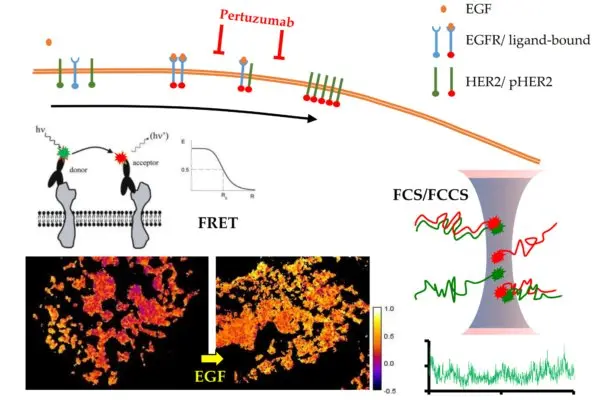 Pertuzumab (Perjeta®) is a humanized antibody that binds to the dimerization arm of HER2 (human epidermal growth factor receptor-2). Unfortunately, pertuzumab has failed as a monotherapy agent in HER2-overexpressing malignancies. Molecular interaction between HER2 and the epidermal growth factor receptor (EGFR) can play an important role in mitogenic signaling and malignant proliferation as a function of EGFR ligand binding. Since pertuzumab can inhibit this interaction, the degree of interaction may be an important predictor of treatment efficacy in addition to HER2 expression and oligomerization. Therefore, the static and dynamic interactions between HER2 and EGFR were investigated in the presence and absence of pertuzumab on EGF-treated, HER2+ EGFR+ SK-BR-3 breast tumor cells as a model system. In our experiments, Förster resonance energy transfer (FRET) based microscopy, fluorescence correlation (FCS) and cross-correlation (FCCS) spectroscopy were applied. The consequential receptor phosphorylation and cell proliferation resulting from transactivation and signal transduction were measured by Western-blot and MTT-reduction assay. The autocorrelation function of HER2 diffusion in the membrane (also corrected for triplet formation) was fitted with a three-component model, containing fast and slow diffusing membrane-HER2 fractions. Interaction of EGFR and HER2 quantified through FRET efficiency increased under EGF stimulus and was inhibited by pertuzumab. The ligand-binding of EGFR caused HER2 aggregation, which caused the slowing down and increase in the ratio of the slowly diffusing membrane HER2-fraction. This induced aggregation of HER2 was effectively prevented by pertuzumab pretreatment, as confirmed by photon count histograms (PCH) and co-diffusing fractions determined by FCCS. In summary, pertuzumab inhibited the interaction between ligand-bound EGFR and HER2, and through this the consequent EGF-induced HER2 aggregation and phosphorylation. This led to a dose-dependent decrease in cell proliferation, especially when higher amounts of EGF were present. Consequently, EGFR expression may be a potential biomarker for predicting the outcome of pertuzumab treatment on HER2-positive tumors.
Pertuzumab (Perjeta®) is a humanized antibody that binds to the dimerization arm of HER2 (human epidermal growth factor receptor-2). Unfortunately, pertuzumab has failed as a monotherapy agent in HER2-overexpressing malignancies. Molecular interaction between HER2 and the epidermal growth factor receptor (EGFR) can play an important role in mitogenic signaling and malignant proliferation as a function of EGFR ligand binding. Since pertuzumab can inhibit this interaction, the degree of interaction may be an important predictor of treatment efficacy in addition to HER2 expression and oligomerization. Therefore, the static and dynamic interactions between HER2 and EGFR were investigated in the presence and absence of pertuzumab on EGF-treated, HER2+ EGFR+ SK-BR-3 breast tumor cells as a model system. In our experiments, Förster resonance energy transfer (FRET) based microscopy, fluorescence correlation (FCS) and cross-correlation (FCCS) spectroscopy were applied. The consequential receptor phosphorylation and cell proliferation resulting from transactivation and signal transduction were measured by Western-blot and MTT-reduction assay. The autocorrelation function of HER2 diffusion in the membrane (also corrected for triplet formation) was fitted with a three-component model, containing fast and slow diffusing membrane-HER2 fractions. Interaction of EGFR and HER2 quantified through FRET efficiency increased under EGF stimulus and was inhibited by pertuzumab. The ligand-binding of EGFR caused HER2 aggregation, which caused the slowing down and increase in the ratio of the slowly diffusing membrane HER2-fraction. This induced aggregation of HER2 was effectively prevented by pertuzumab pretreatment, as confirmed by photon count histograms (PCH) and co-diffusing fractions determined by FCCS. In summary, pertuzumab inhibited the interaction between ligand-bound EGFR and HER2, and through this the consequent EGF-induced HER2 aggregation and phosphorylation. This led to a dose-dependent decrease in cell proliferation, especially when higher amounts of EGF were present. Consequently, EGFR expression may be a potential biomarker for predicting the outcome of pertuzumab treatment on HER2-positive tumors.